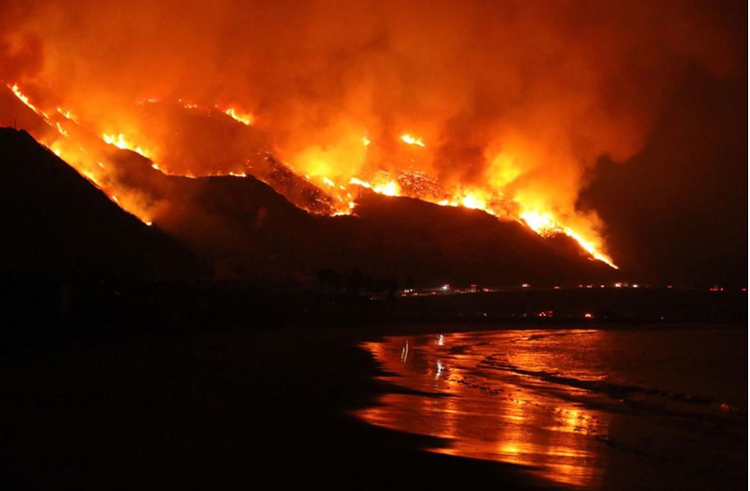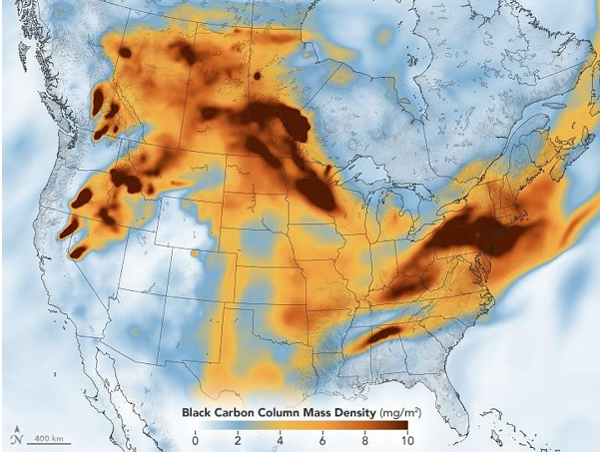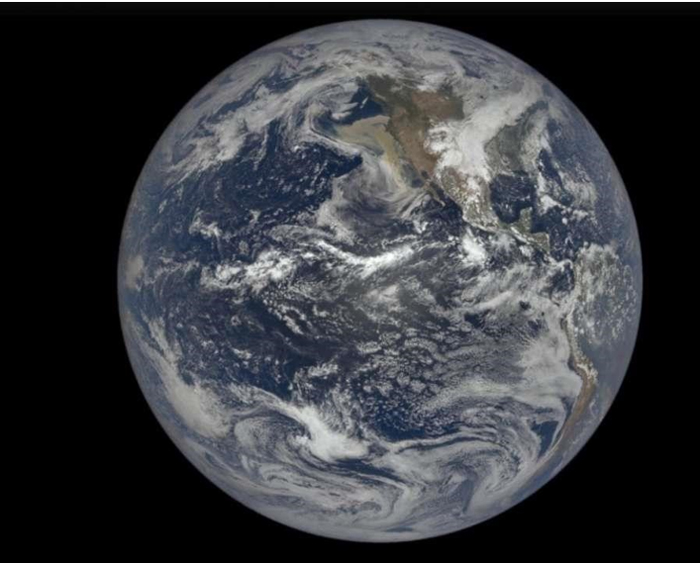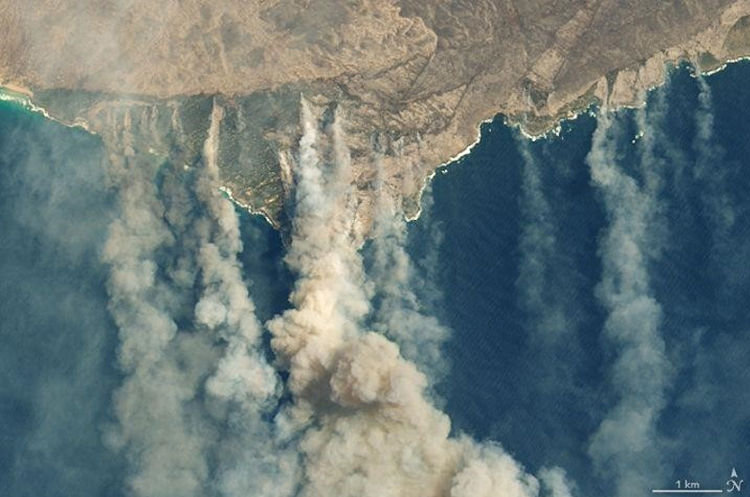Feature
Update 2021/10/3
Oceans
Are Wildfire Smoke Fumes Impacting Oceans?
by Suzanne Forcese
Researchers are beginning to understand the atmospheric inputs of dissolved black carbon to coastal ecosystems impacted directly by wildfire.
An Interview with Northeastern University’s (Boston) Dr. Aron Stubbins, professor of marine and environmental sciences; chemistry and chemical biology; and civil and environmental engineering.

The Thomas Fire, affecting Ventura and Santa Barbara Counties in California, ignited in
December, 2017, burned approximately 281, 893 acres (440 sq mi) before being fully contained on January 18, 2018. The more than month long burn made it the largest wildfire in modern California history at the time (it currently ranks as seventh).
Santa Ana winds lofted plumes of smoke and ash over the Santa Barbara Channel.
The Research
JGR Biogeosciences Research Article: “Investigating Atmospheric Inputs of Dissolved Black Carbon to the Santa Barbara Channel During the Thomas Fire” (California USA), Sasha Wagner et al.
“Sampling the Thomas Fire was not planned,” Dr. Aron Stubbins told WT.
“Colleagues (Elizabeth Harvey, now at UNH) and then post-doctoral student, Sasha Wagner (now professor at Rensselaer Polytechnic, NY) had a research cruise already scheduled to study the ocean offshore of California.
“As they were planning the research, the fire started, and they realized their cruise would provide an opportunity to sample underneath the smoke plume.”

July 21, 2021 NASA Earth observatory map showing the concentration of black carbon particulates (soot) over North America (Image Joshua Stevens)
Clouds of smoke from wildfires stretch beyond their source affecting air quality. As well, the black carbon or “soot” spreads over waterways and eventually reaches the oceans.

A muddy coloured smoke plume over the Pacific Ocean just off the West Coast captured by a camera aboard the DSCOVR spacecraft a million miles from Earth. NASA 2020
“The scientists at sea collected water samples that were then sent back to us at Skidway Institute of Oceanography (Savannah, GA). Samples were analyzed for dissolved black carbon using a high-pressure liquid chromatography system with an isotope ratio mass spectrometer as the detector (HPLC-IRMS).
“This method allows us to distinguish between dissolved black carbon made on land and that found in the open ocean.
“Although an increase in dissolved black carbon concentrations was observed in the coastal ocean during the fire, it was unclear from the isotopes where this material came from. More work is required to assess the importance of direct inputs from fire plumes to the coastal ocean.”
The Chemical Biology
“When fire burns through a forest, much of the carbon that makes up the tree is converted to carbon dioxide and released to the atmosphere. However, some of the carbon does not burn completely and charred remains of the tree are left behind.
“This heat-damaged organic carbon is termed black carbon and includes a wide array of organic molecules. Some of these molecules are lightly cooked -- like the starchy molecules in flour that become more digestible when we bake bread.
“Lightly cooked molecules often become more water soluble and more bioavailable to bacteria than the molecules that were originally in the tree.
“While baking bread makes flour easier to digest, burning toast until it turns black and sets off the fire alarm creates an inedible black residue. This is the burnt end of the spectrum, where molecules that were once flour or tree are now so burnt that they have been reduced to forms of highly unbioavailable black carbon.
“The chemical structures responsible for the dark color of charred toast and trees are condensed aromatics.
“These molecules are not as soluble or bioavailable as the original molecules. Because these colored, black carbon molecules resist biodegradation, they have accumulated on Earth to become a major global carbon store.”
Smoke Over the Ocean
“When wildfires burn, some of the soot and other particles produced end up being deposited to the forest floor and only making it out to sea much later when a river mobilizes them. However, when a fire occurs on the coast, some soot laden with black carbon can be blown straight out to sea.
“It remains unclear what impacts this may have, although a recent paper
(“Widespread phytoplankton blooms triggered by 2019-2020 Australian wildfires”, Weiyi Tang, et al) showed that iron may be carried offshore with dust and lead to an increase in productivity in local waters.”

Australia’s deadly wildfires in 2019-2020 torched 74,000 sq km of eucalyptus forest, increasing anthropogenic carbon emissions by more than a third over the previous year.
Thick plumes of smoke spewed CO2 emissions and mineral-laden aerosols into the atmosphere. Researchers have linked these emissions to an algal bloom larger than the
Australian continent that formed several thousand kilometers away in the Southern Ocean.
NASA/USGS/Landsat/Lauren Dauphin
Algal Blooms
“The world and its different systems are connected,” Stubbins adds, commenting on the Australian fires. “This new study (2021) revealed how fire on land can deliver important nutrients to the coastal ocean. In this way, a fire on land may devastate a forest, but provide the nutrients to fuel new growth in ocean surface waters.
“The links are poorly understood at present. In many cases, some additional phytoplankton (algae) blooming in the ocean is a good thing in that it may act to draw more carbon dioxide from the atmosphere, potentially offsetting the impact of carbon emissions by people and offsetting some of the carbon dioxide emissions from the fires.
“However, to understand whether this positive effect is important and long lasting, much more work is required to assess how much and what type of growth coastal fires promote in the coastal ocean.”
Future Research
“Black carbon is one of the major pools of carbon on Earth. It is therefore critical to the carbon budget of the planet and climate. Future work in my group will continue to build a better understanding of the black carbon budget and how it may be changing due to human activity – and in turn, how changes to black carbon cycling may feedback to impact future climate and ecosystem health.”
The Stubbins Lab research focuses on environmental chemistry, geochemistry, the carbon cycle, freshwater, coastal and ocean biogeochemistry, feedbacks between natural biogeochemical cycles and climate change, permafrost, black carbon and aquatic microplastics.
suzanne.f@watertoday.ca
|